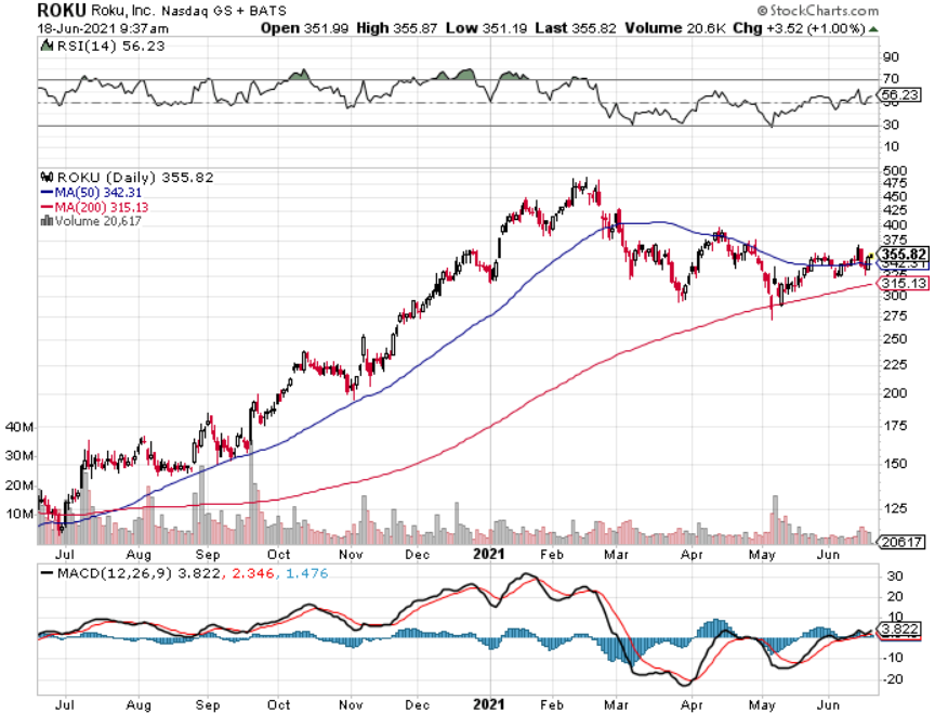If Apple is a $2.2 trillion company, then Roku growing from today’s $47 billion to $100 billion is highly likely.
I would agree that the digital migration and transformation are mainly funneled into the profit models of the big tech players, but tech companies created from the ilk of Roku aren’t shabby either.
The TV streaming platform Roku has a 3-year revenue growth rate of 54% showing they are a true growth firm no matter what metric you want to measure them against.
The pandemic supercharged their business with revenue growth rates soaring to a record 79% year over year to $574.2 million.
Roku users streamed 18.3 billion hours in the quarter, an increase of 49% year over year. Platform monetization continued to increase with average revenue per use (ARPU) of $32.14 on a trailing 12-month basis, up 32% year over year.
This was in large part because they added 2.4 million incremental active accounts in Q1, ending the quarter with 53.6 million.
The success can also be attributed to a secular shift in the advertising industry.
Historically, the biggest impediment or headwind to Roku’s ad business growth has been TV buyers' buying patterns.
Buyers traditionally tend to prefer traditional linear TV versus a bold new phenomenon-like streaming.
Certainly, there's a gap there as viewers move over to streaming versus the ad dollars.
That gap is now closing and there’s still room to expand.
For example, according to Nielsen, in March ratings, linear TV ratings for adults 18 to 24 were down 22%. Q1 TV ad spending was down 11%, according to MediaRadar. Meanwhile, Roku was able to double monetized video ad impressions on the platform.
Ad spending by major agency holding companies with Roku more than doubled. We saw strength really up and down Roku’s ad business. An area of strength is inevitably the entertainment side of Roku’s ad business and it’s to the point where every major direct-to-consumer service has launched.
Those launches have created great opportunities for Roku to partner with major service providers, HBO Max, Discovery Plus, and the who’s who to really drive the adoption of these services, and these partners are leaning in closely and investing with Roku to promote their services to Roku’s users.
Another example is Home Chef, a performance-based advertiser, who invested with Roku and saw 2.4 times return on ad spend and then came back and significantly invested more with Roku after the preliminary success.
Similar case studies pop up like that left and right.
What we are seeing now is the reallocation of TV budgets, as well as digital and social budgets toward streaming and it is here to stay.
As the sales growth rate has gone from the mid 50% to the high 70%, Roku forecasts the same type of outperformance which calls for robust growth with total net revenue of $615 million at the midpoint, up 73% year over year; and total gross profit of $300 million at the midpoint, up 104% year over year, implying an overall gross margin of approximately 49%.
As streaming becomes the dominant source of entertainment around the globe, advertisers are moving much of their traditional TV budgets to over-the-top media services (OTT). The need for programmatic, measured, and scalable advertising opportunities across devices is more important than ever.
This bodes well for continuing to be able to command premium cost per mille (CPMs).
Advertisers will increasingly be looking not just at the top-line CPM that they buy the media at, but the effective cost, cost per site visit, cost per product purchase.
And what that means long term is that, unlike traditional TV, streaming CPMs aren't just going to be sort of one price rules them all type scenario, but rather a whole spectrum of prices where the pricing into the auction is ultimately dictated by the tactic that the advertiser is executing on and the outcome that they're trying to drive.
As Roku delivers enhanced tools to navigate this type of auction and pricing and allow effective strategies to flourish, they will benefit from all of this.
One note investors need to take heed of is that even though Roku anticipates revenue growth rates in the second half of 2021 will be robust, they will be “at a slower rate than the first half.”
The reason they give for this is because they expect the “outperformance of content distribution to normalize in Q2 and in the back half of the year.”
If we look at Roku’s stock chart, Roku has come back drastically from $470 in mid-February to $350 today as the market had to absorb perceived higher interest rate fears and accelerating inflation.
There was a swift rotation out of high growth names during this period causing a rapid pullback in Roku.
Theoretically, the upside is capped in 2021 in the second half because growth rates will moderate, and the stock will be reliant on a Nasdaq lunge forward as in index to carry them back to the highs of February.
The low-hanging fruit has been harvested because the premium entertainment deliverers have already signed up for the Roku platform.
Thus, don’t expect any paradigm-shifting announcement in 2021 but expect solid earnings and higher profitability.
I would put new capital to work around the support levels of $315 or $300.
Roku is still performing at growth rates in the high 70% year-over-year and has been a profitable company since Q3 2020.
These two trends will stick and if you remember in 2018, I recommended this stock at $26 and still love it at around $300.




